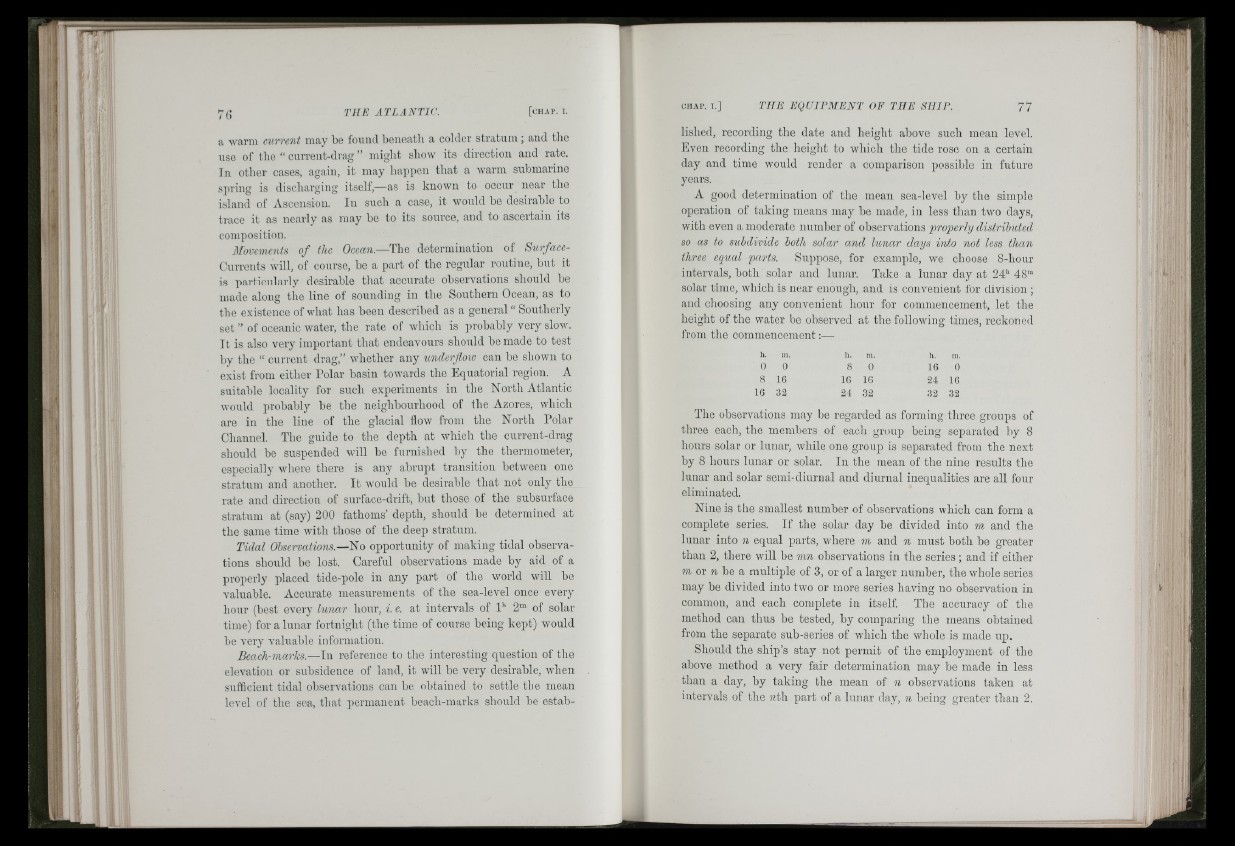
i A
a v'ann current may be found beneath a colder stratum ; and tlie
use of the “ cnrrent-drag ” might show its direction and rate.
In other cases, again, it may liappen that a warm submarine
spring is discliarging itself,—as is known to occur near the
island of Ascension. In such a case, it would be desirable to
trace it as nearly as may be to its source, and to ascertain its
composition.
Movements of the Ocean.—The determination of Surface-
Currcnts will, of course, be a part of the regular routine, but it
is particularly desirable tliat accurate observations sliould be
made along tlie line of sounding in tlie Southern Ocean, as to
tlie existence of wliat lias been described as a general “ Soutlierly
set ” of oceanic water, tbe rate of which is probably very slow.
I t is also very important that endeavours should be made to test
i)y the “ current drag,” wlietlier any underflow can he sliown to
exist from eitiier Polar basin toivards tlie Equatorial region. A
suitable locality for sucli experiments in the North Atlantic
would probably be tiie neighbourhood of the Azores, whicli
are in the line of the glacial flow from tlie North Polar
Cliannel. The guide to tiie depth at which the current-drag
sliould be suspended will he furnished by the thermometer,
especially where tiiere is any abrupt tra.nsition between one
stratum and anotlier. I t would be desirable that not only tiie
rate and direction of surface-drift, but those of the subsurface
stratum at (say) 200 fathoms’ depth, should be determined at
tiie same time with those of the deep stratum.
Tidal Obsemations.—No opportunity of making tidal observations
sliould be lost. Careful observations made by aid of a
properly placed tide-pole in any part of tbe world wiil be
valuable. Accurate measurements of the sea-level once every
lioiir (best every lunar hour, i. e. at intervals of 1‘‘ 2“ of solar
time) for a lunar fortnigiit (the time of course being kept) would
be very valuable information.
Beach-marhs.—In reference to tlie interesting question of tlie
elevation or subsidence of land, it will be very desirable, rvhen
sufficient tidal observations can be obtained to settle tlie mean
level of tlie sea, that permanent heach-inarks should he establisiied,
recording the date and heiglit above such mean level.
.Even recording tlie heiglit to which the tide rose on a certain
day and time would render a comparison possible in future
years.
A good determination of the mean sea-level by the simple
operation of taking means may be made, in less than two days,
with even a moderate number of observations properly distributed
so as to subdivide both solar and lunar days into not less than
three equal parts. Suppose, for example, we choose 8-hour
intervals, both solar and lunar. Take a lunar day at 2U 48™
solar time, which is near enough, and is convenient for division ;
and choosing any convenient hour for commencement, let the
height of the water be observed at the following times, reckoned
from the commencement:—
h. in.
0 0
8 16
16 32
h. m.
8 0
16 16
24 32
h . m .
16 0
24 16
32 32
The observations may be regarded as forming tliree groups of
three each, the members of each group being separated hy 8
hours solar or lunar, wliile one group is separated from the next
by 8 hours lunar or solar. In the mean of the nine results the
lunar and solar semi- diurnal and diurnal inequalities are all four
eliminated.
Nine is the smallest number of observations which can form a
complete series, If the solar day be divided into m and the
lunar into n equal parts, where m and n must both be greater
than 2, there wiil he mn observations in the series; and if either
m or 71 be a multiple of 3, or of a larger number, the whole series
may be divided into two or more series having no observation in
common, and each complete in itself. The accuracy of the
method can thus be tested, by comparing tbe means obtained
from the separate sub-series of which the whole is made up.
Should the ship’s stay not permit of the employment of the
ahove method a very fair determination may be made in less
than a day, by taking the mean of n observations taken at
intervals of the 7ith part of a lunar day, n heing greater than 2.